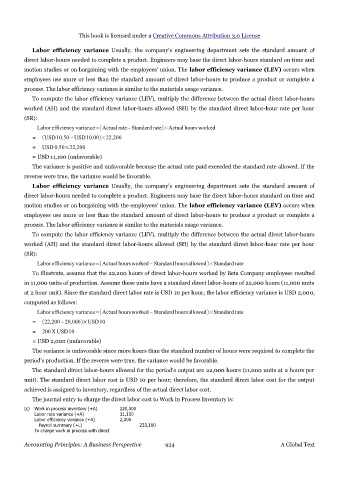Page 923 - Accounting Principles (A Business Perspective)
P. 923
This book is licensed under a Creative Commons Attribution 3.0 License
Labor efficiency variance Usually, the company's engineering department sets the standard amount of
direct labor-hours needed to complete a product. Engineers may base the direct labor-hours standard on time and
motion studies or on bargaining with the employees' union. The labor efficiency variance (LEV) occurs when
employees use more or less than the standard amount of direct labor-hours to produce a product or complete a
process. The labor efficiency variance is similar to the materials usage variance.
To compute the labor efficiency variance (LEV), multiply the difference between the actual direct labor-hours
worked (AH) and the standard direct labor-hours allowed (SH) by the standard direct labor-hour rate per hour
(SR):
Labor efficiency variance=Actual rate– Standard rate×Actual hours worked
= USD10.50 – USD10.00×22,200
= USD 0.50×22,200
= USD 11,100 (unfavorable)
The variance is positive and unfavorable because the actual rate paid exceeded the standard rate allowed. If the
reverse were true, the variance would be favorable.
Labor efficiency variance Usually, the company's engineering department sets the standard amount of
direct labor-hours needed to complete a product. Engineers may base the direct labor-hours standard on time and
motion studies or on bargaining with the employees' union. The labor efficiency variance (LEV) occurs when
employees use more or less than the standard amount of direct labor-hours to produce a product or complete a
process. The labor efficiency variance is similar to the materials usage variance.
To compute the labor efficiency variance (LEV), multiply the difference between the actual direct labor-hours
worked (AH) and the standard direct labor-hours allowed (SH) by the standard direct labor-hour rate per hour
(SR):
Labor efficiency variance=Actual hoursworked – Standard hoursallowed×Standard rate
To illustrate, assume that the 22,200 hours of direct labor-hours worked by Beta Company employees resulted
in 11,000 units of production. Assume these units have a standard direct labor-hours of 22,000 hours (11,000 units
at 2 hour unit). Since the standard direct labor rate is USD 10 per hour, the labor efficiency variance is USD 2,000,
computed as follows:
Labor efficiency variance=Actual hoursworked – Standard hoursallowed×Standard rate
= 22,200 – 20,000×USD10
= 200 X USD10
= USD 2,000 (unfavorable)
The variance is unfavorable since more hours than the standard number of hours were required to complete the
period's production. If the reverse were true, the variance would be favorable.
The standard direct labor-hours allowed for the period's output are 22,000 hours (11,000 units at 2 hours per
unit). The standard direct labor cost is USD 10 per hour; therefore, the standard direct labor cost for the output
achieved is assigned to inventory, regardless of the actual direct labor cost.
The journal entry to charge the direct labor cost to Work in Process Inventory is:
(c) Work in process inventory (+A) 220,000
Labor rate variance (+A) 11,100
Labor efficiency variance (+A) 2,000
Payroll summary (+L) 233,100
To charge work in process with direct
Accounting Principles: A Business Perspective 924 A Global Text

